




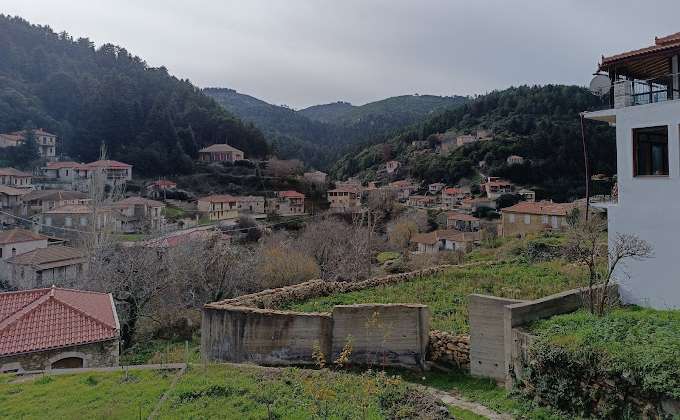

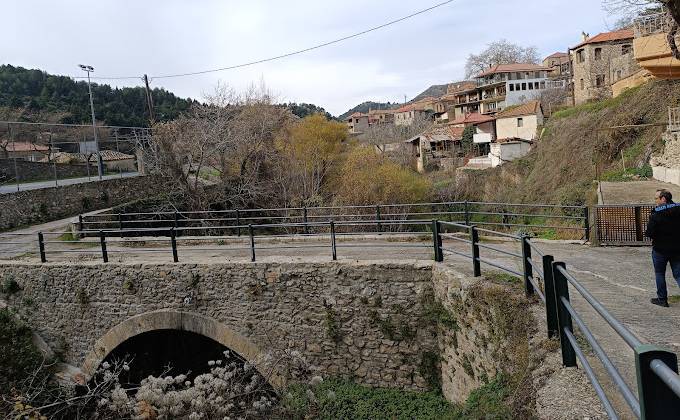
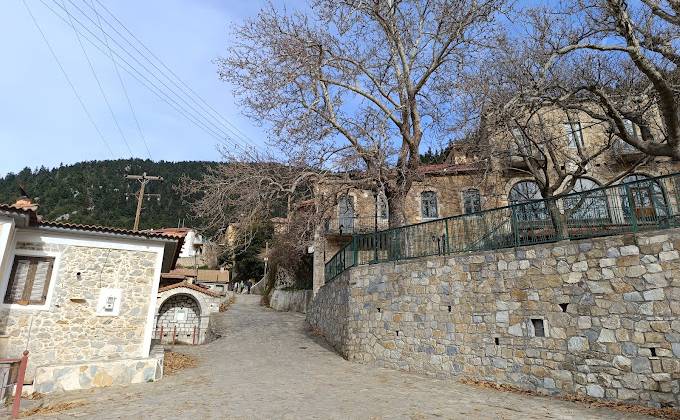
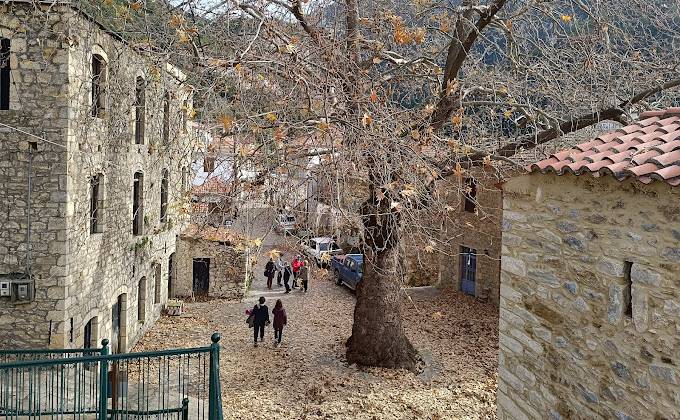
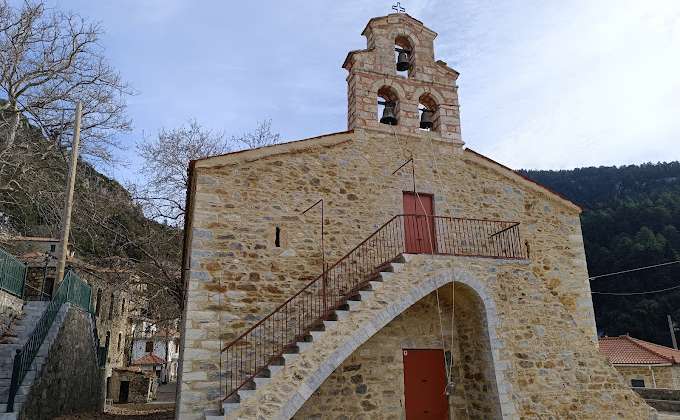

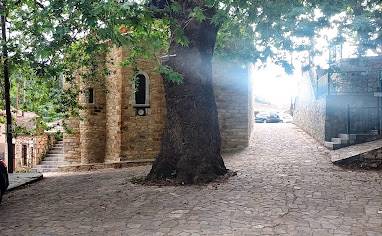
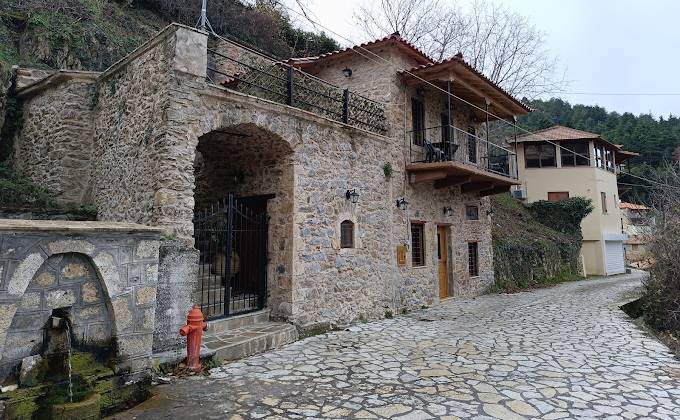
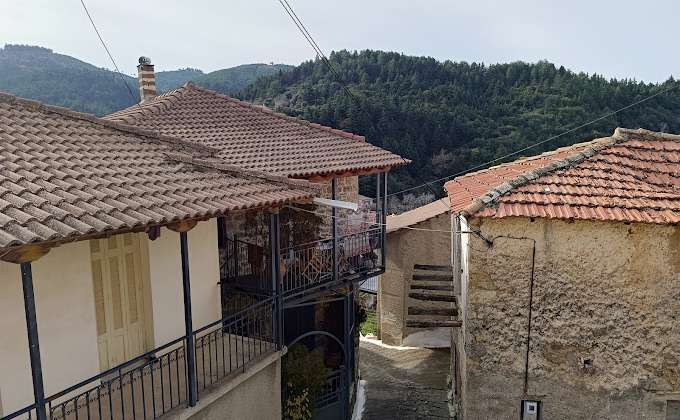
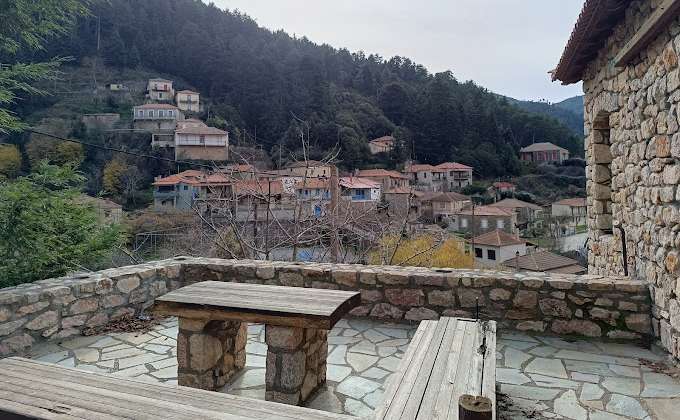
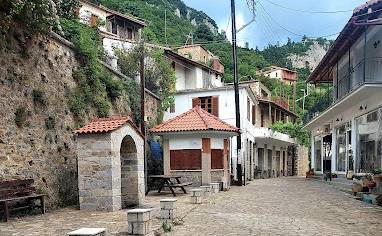
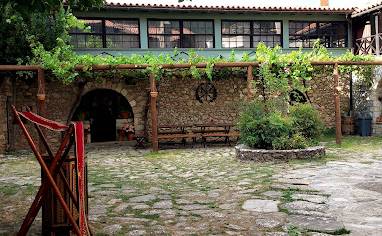
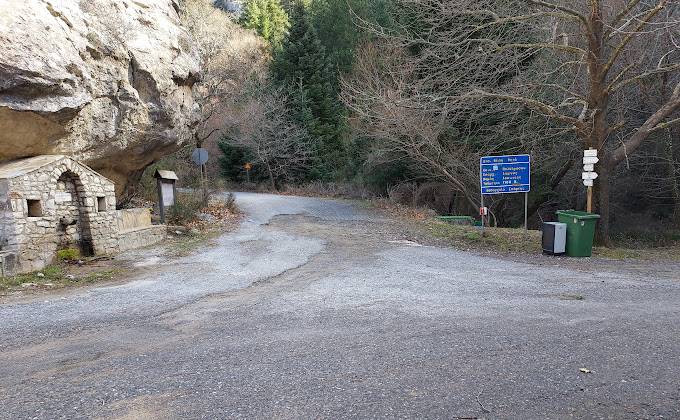
The mountain village of Polydroso is built on the slopes of Mount Parnon, at an altitude of 1100 metres, in a green valley. It is 35 km from Sparta and 42 km from Mystras. It has about 50 permanent residents, who in winter move to the semi-mountainous village of Goritsa. During the summer months, the village is full of locals and visitors.
The name Polydroso was imposed during the years of the dictatorship of 1976. In the past, the village was called Tsintzina, and the inhabitants spoke the Tsakonian dialect, which is spoken in the area of southern Kynouria in Arcadia. From antiquity until 1912, south Kynouria belonged to ancient Sparta and the prefecture of Laconia, respectively. The first author to mention the existence of the Tsakonian dialect was Mazaris (Greek Byzantine writer) in the 15th century.
Tsintzina was inhabited for the first time during the Byzantine period. The Monastery of Agioi Anargyroi, which played an essential role in the area, was built at that time. Historically, Tsintzina is presented for the first time in a Byzantine Golden Bullion of 1292, or according to others in 1295. It is one of the newest villages in the area of Parnon, and there are various theories about the creation of the village. Some argue that Tsintzina was first created as a settlement for the workers of the adjacent Monastery of Agioi Anargyroi. Most likely, the village owes its name to the area's topography. According to Thanasis Kostakis' dictionary, the word "tsintzina" is an old Tsakonian word and means "small knot". So, the interpretation of the village's name is "junction" or "crossroads".
Towards the end of the 17th century, two French explorers who travelled to the Peloponnese wrote about Tsintzina: "The inhabitants were hospitable. They used to stand at a place, watching the strangers passing by, whom they called by hitting a seashell to show them that there is a village hanging on a rock." When the Venetians conquered the lands of the Peloponnese, only 144 people lived in Tsintzina. In 1715, the Ottomans expelled the Venetians from the area, and the village passed into their possession. Then the economic development of the village began. The inhabitants were engaged in the textile industry, cotton, wool and timber, having trade relationships with countries abroad and the markets of Mystras and Tegea.
During the Greek Revolution, the inhabitants actively participated in the struggle against the Turks. In fact, they sided with Kolokotronis in the battle of Dervenaki on July 26th, 1822. In 1825, during the attacks of Ismail Pasha, Theodoros Kolokotronis visited the village and lived for some time on Parnon with his fighters to regroup his forces. After the Liberation, Tsintzina had a population of 1,344.
Later, many settled in the villages of Goritsa and Zoupena, where they lived from October to June. However, in the 1850s, many immigrated to Egypt. The reason for the village's abandonment was the vendetta that broke out between two dominant families of Zoupena, the Koumoutzas family and the Gerasimos family. The vendetta, which lasted several years, divided the village, and a series of violent incidents forced many residents to flee abroad.
In the village of Polydroso, visitors can admire the natural beauty with the century-old firs and wander the cobbled alleys with the lilies and the stone-built, traditional houses. The houses are built amphitheatrically at the top of the three hills of the village, while nine springs, on the broader area, gush crystal clear water. It is an ideal destination for those looking for peace and relaxation. In contrast, for the most active ones, there is the option of hiking or cycling excursions on Mount Parnon and, especially at its top, Megali Tourla, which has an altitude of 1942 metres. This area on the mountain is dominated by the traditional guesthouse "Prytaneio" (which consists of three stone buildings), in an area with many springs and overgrown with firs and black pines.
Nine hiking trails start from the centre of the village and lead to caves, fountains and picturesque churches. All routes are mapped and marked, and each has a different degree of difficulty. One ends at the Koniaki fountain and returns to the village, following a circular course in the forest. The oldest monument of the village is the cave church of Agios Ioannis, built just outside Polydroso. The temple is one with the mountain. To enter, one must go through a small door, while there are four different levels (floors). The hagiographies date from 1333 or 1335 AD, while the outer fortification wall was built during Ibrahim's raids in 1826. In fact, during the years of Ismail Pasha's raids, the inhabitants found refuge there.
The "jewel" of the village is the traditional guest house in the square with the plane trees. The restored building of the old Primary School was built in 1891 with a donation given by benefactor Ioannis Grigoriou, and the schoolyard is, today, the area of the square. In Polydroso and the wider region, visitors can also admire the many remarkable churches, such as Agia Marina's chapel and Agios Vlassis' church. In fact, this church is the oldest in the village, with excellent hagiographies made by Kontoglou and Dimitrios Kakavas. The church of Panagia (the Virgin Mary) also stands out, which, according to tradition, was built in forty days. It celebrates on the 15th of August and on that day a big festival is organised with rich food, wine and live music. Finally, a special place is occupied by the chapel of Panagia of the Cell, maintained in excellent condition. It is a triangular, Athonite type temple without a dome and dates back to the 16th century. Its stone walls are very thick, while the roof is made of Byzantine tiles. In the area around the church, the traces of a Hidden School, which operated in an underground hall, are preserved to this day.
In recent years in Polydroso, the "Cultural Agnantia of Parnon" has been organised during the summer months. It is a cultural event which takes place in the central square of the village, under the auspices of the Cultural Association "Tsintzina". It should be noted that doctor, poet and writer Giannis Vouloumanos came from Polydroso. His first poetry collection was published in 1978 under the title: "In Search of Apsyrtos". In fact, the "Cultural Agnantia of Parnon" of 2019 was dedicated to his memory. Also, journalist and poet Giannis K. Andritsakis, also known as "Motivos", came from Polydroso. At the village square, the visitor can see his three-storey stone house where he "lived, worked and thought", according to the wall plaque next to the entrance. From 1961 to 1980, "Motivos" published the historic newspaper “Tsintzina".